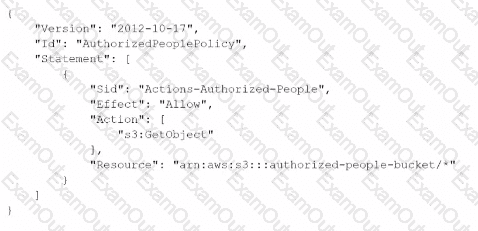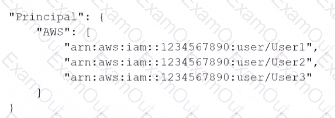A company finds that one of its Amazon EC2 instances suddenly has a high CPU usage. The company does not know whether the EC2 instance is compromised or whether the operating system is performing background cleanup.
Which combination of steps should a security engineer take before investigating the issue? (Select THREE.)
A company has retail stores The company is designing a solution to store scanned copies of customer receipts on Amazon S3 Files will be between 100 KB and 5 MB in PDF format Each retail store must have a unique encryption key Each object must be encrypted with a unique key
Which solution will meet these requirements?
A Development team has built an experimental environment to test a simple stale web application It has built an isolated VPC with a private and a public subnet. The public subnet holds only an Application Load Balancer a NAT gateway, and an internet gateway. The private subnet holds ail of the Amazon EC2 instances
There are 3 different types of servers Each server type has its own Security Group that limits access lo only required connectivity. The Security Groups nave both inbound and outbound rules applied Each subnet has both inbound and outbound network ACls applied to limit access to only required connectivity
Which of the following should the team check if a server cannot establish an outbound connection to the internet? (Select THREE.)
A company has deployed AWS Control Tower and an organization in AWS Organizations to manage its AWS accounts. The company needs to implement the AWS Foundational Security Best Practices standard and must centrally log findings for the organization into one account.
Which solution will meet these requirements?
A development team is attempting to encrypt and decode a secure string parameter from the IAM Systems Manager Parameter Store using an IAM Key Management Service (IAM KMS) CMK. However, each attempt results in an error message being sent to the development team.
Which CMK-related problems possibly account for the error? (Select two.)
A company has multiple accounts in the AWS Cloud. Users in the developer account need to have access to specific resources in the production account.
What is the MOST secure way to provide this access?
A company is building an application on IAM that will store sensitive Information. The company has a support team with access to the IT infrastructure, including databases. The company's security engineer must introduce measures to protect the sensitive data against any data breach while minimizing management overhead. The credentials must be regularly rotated.
What should the security engineer recommend?
A company is running an application on Amazon EC2 instances in an Auto Scaling group. The application stores logs locally. A security engineer noticed that logs were lost after a scale-in event. The security engineer needs to recommend a solution to ensure the durability and availability of log data All logs must be kept for a minimum of 1 year for auditing purposes. What should the security engineer recommend?
A company must create annual snapshots of Amazon Elastic Block Store (Amazon EBS) volumes. The company must retain the snapshots for 10 years. The company will use AWS Key Management Service (AWS KMS) to encrypt the EBS volumes and snapshots.
The encryption keys must be rotated automatically every year. Snapshots that were created in previous years must be readable after rotation of the encryption keys.
Which type of KMS keys should the company use for encryption to meet these requirements?
A security engineer needs to create an Amazon S3 bucket policy to grant least privilege read access to IAM user accounts that are named User=1, User2. and User3. These IAM user accounts are members of the AuthorizedPeople IAM group.The security engineer drafts the following S3 bucket policy:

When the security engineer tries to add the policy to the S3 bucket, the following error message appears: "Missing required field Principal." The security engineer is adding a Principal element to the policy. The addition must provide read access to only User1. User2, and User3.Which solution meets these requirements?
A)

B)

C)

D)


